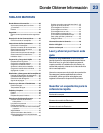
18
Solutions to Common Problems
IMPORTANT
Before calling for service, review this list. It may
save you both time and expense. This list
includes common experiences that are not the
result of defective workmanship or material in
your dishwasher.
FOOD SOILS LEFT ON
DISHES
• Check incoming water temperature. (See
Getting Started, page 5.) It should be at least
120°F (49°C). (See Factors Affecting
Performance, page 15.)
• Choose another cycle for longer washing
time.
• Check rack loading section for proper
loading—avoid nesting items.
• Home water pressure may be too low—
should be 20 to 90 pounds per square inch
(psi).
• Check water hardness. For extremely hard
water, it may be necessary to install a water
softener. (See Detergent Usage Guide, page
13.)
• Use fresh detergent.
• Make sure items are not blocking any of the
spray arms, preventing them from rotating.
DISHES NOT DRY
• Make sure the rinse aid dispenser is filled.
• Increase the amount of rinse aid (See Rinse
Aid, page 14).
• Check the incoming water temperature. Be
sure it is at least 120°F (49°C).
• Check for proper loading—avoid nesting
items.
• Plastic items may need to be towel dried.
Less water evaporates from plastic items
when cycle is complete because they do not
retain as much heat as glass or metal items.
• Cups with a concave bottom will collect
water.
DISHWARE CHIPPED
• Load with care and do not overload. (See
Preparing and Loading Dishes, pages 9-11.)
• Place delicate items in top rack.
• Place glasses securely against pins and not
over pins.
• Load items so they are secure and don’t jar
loose when moving racks in and out. Move
racks in and out slowly.
• Make sure tall glasses and stemware will
clear top of tub when rack is pushed in.
• It is recommeded to wash fine antique china
and crystal by hand.
DISPLAY NOT IN OPERATING
MODE
• Hold down SANITIZE touchpad for 8 seconds
to reset unit to Normal Operating Mode.


















